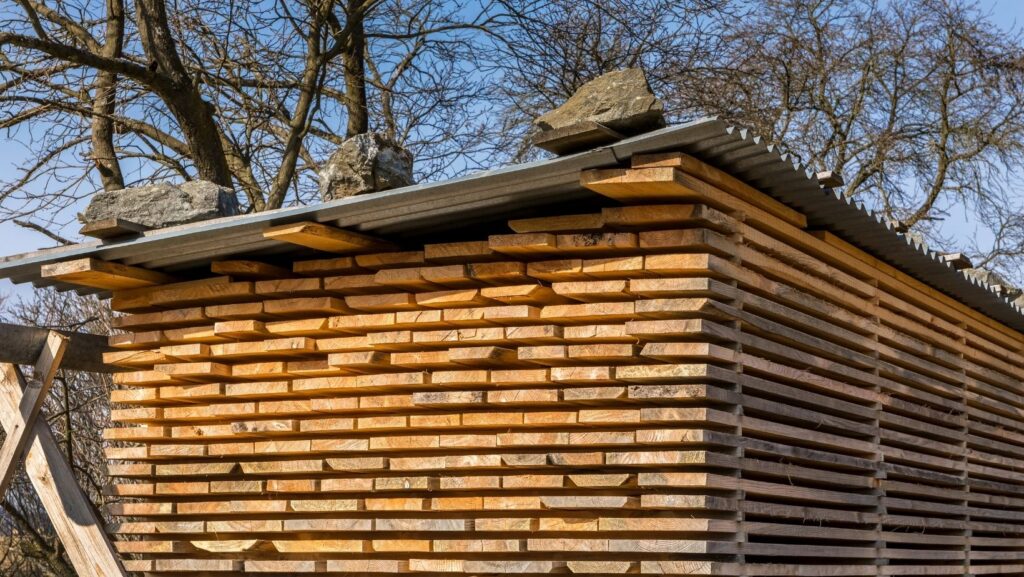It’s common for someone outside our industry to wonder what we are talking about when we mention our kiln.
Wood maintains moisture well. Too well if you ask anyone who works with wood.
Since green lumber as well as old reclaimed boards cannot be used for anything related to timber products or building materials due to its high moisture content, drying the lumber becomes one of the most important steps before doing anything.
Using kilns is the ultimate option to avoid moisture-related problems that include warping and twisting in dimensional lumber, binding or kicking during manufacturing, buckling or crowning in an installed wood floor, and adhesive failures in finished products which automatically lead to massive financial losses.
So let’s take a closer look at what kiln drying wood is and what are the different types of wood kilns used in the lumber industry.
What Is Kiln Drying?
Moisture levels are high in green lumber, which is why it’s important to choose wood that has been kiln dried. This drying method is a common practice that draws moisture out of the wood. Everything happens through the process of extracting water vapor from green lumber, which is then condensed and cooled down in an oven called a “kiln.”
As soon as the wood has attained the appropriate moisture content, it is run through the planer for final dimensioning, grading, and delivery. For wood flooring or other particular end products, the wood is often delivered to a factory for further cutting, treating, and finishing.
The major benefit of this drying method is that it is a highly efficient method compared to natural drying, as it ensures that the wood is treated with care and dried without damage.
Why Must Lumber Have Low Moisture Level?
The major reason why lumber has to have a low moisture level is to protect the timber from decaying or bending. If the moisture levels are too high, the lumber will begin to retain humidity, and this may cause the timber to decay or shift. That’s why Using a wood kiln will help ensure a thorough drying process.
By choosing wood that has been kiln dried, you may be guaranteed that your project will survive for many years.
Which Wood Kiln Is Better?
There are many types of wood kilns and each type is defined by the way in which the temperature and humidity are controlled. While conventional and dehumidification kilns are the most commonly used, vacuum and solar kilns are used for special conditions and applications.
Conventional Kilns
A conventional kiln has pipes that radiate heat into its chamber, which is forged from steam or by hot water coils. Then the wood is heated by burning its content of biomass. The moisture content of wood is converted into vapor, which then is released through the hot air. This type of wood kiln needs constant heat to keep air circulating, which demands a significant amount of energy for the wood to completely dry. A conventional kiln can typically dry 1-inch-thick green lumber down to 18%(1). For example, red oak takes almost 28 days to dry down to 8%(2).
Dehumidification Kilns
Kiln dried wood that is based on using the dehumidification system is advantageous because it generates a lot of environmental benefits. These kilns use a heat pump system that extracts moisture out of the wood as the evaporated water is condensed on the refrigeration coils. The generated condensation is drained as a cool liquid instead of being released as warm air.
A dehumidification system uses electricity, which can be costlier than gas. However, the energy that is used to run the system is minimal since the heat is constantly recycled.
Vacuum Kilns
Vacuum kilns are known for their high-drying speed systems. However, they are costlier than either conventional or dehumidification kilns since the heat of vaporization is being provided by electricity instead of local fossil fuel.
Atmospheric pressure determines the boiling point of water. The lower the pressure, the lower the temperature at which water boils. For example, water boils at a lower temperature up a mountain than at its base. So unless you can haul your vacuum kiln to the top of the Himalayas, it’s going to take more energy down where we commoners live.
Solar Kilns
A solar kiln relies on solar collectors to heat the air inside it. Then sunlight is absorbed by the collectors, which transfer the heat to the air. These wood kilns usually use electric-powered fans to enable the air to freely circulate through the wood.
However, solar drying is a very expensive process and because of the long drying times, you’ve got to run the fans a long time making the drying quite expensive.
We welcome you to make an appointment to come by our manufacturing facility to witness our drying tools in action. We have a few conventional kilns at our facility: two big units names Nyle l500 and one smaller unit, the Nyle l200. You could say we dry lots of wood!
Why is kiln drying better than air drying ?
Instead of waiting several months, your kiln dried wood can be ready within only a few weeks. In fact, advancements in wood drying technology have reduced the time it takes, lowered the risks of damaging your lumber, and reduced other costs.
Kiln dried wood is your ultimate choice since the drying method is a great way of purging timbers of mold and insect infestation. As the temperature can reach 176 °F (80 °C) on the last days of drying, it automatically kills any insects and sanitizes the lumber from any kind of fungus or even eggs.
(1) (2) ‘‘Kiln’’, Wikipedia The Free Encyclopedia, 2 June 2021, en.wikipedia.org/wiki/Kiln#Wood-drying_kiln
(3) marcusgrooms, ‘‘Air Drying vs. Kiln Drying : Which is best? ’’, Ohio Wood Connection, August 11, 2020,














